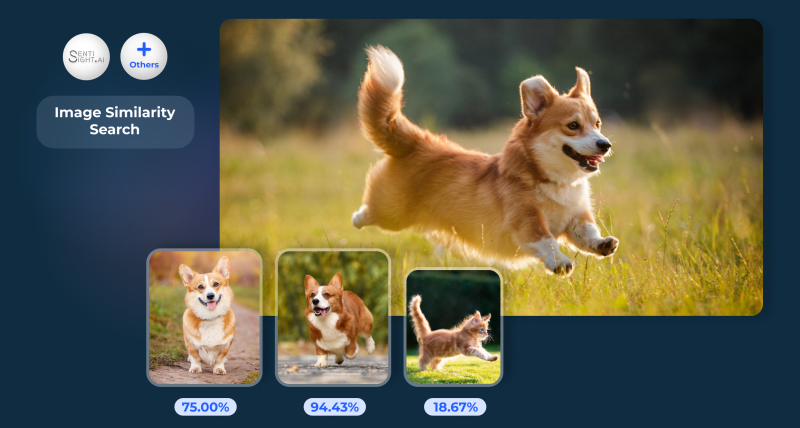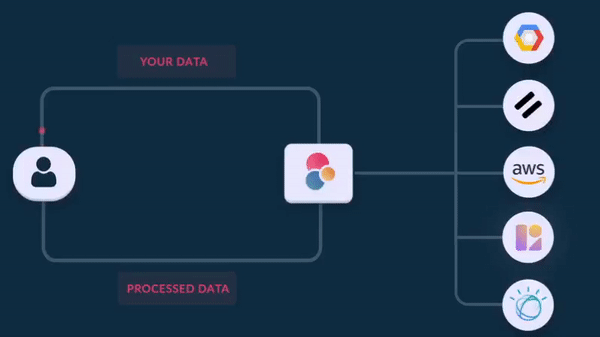What is Image Similarity Search API?
Image similarity search, also called content-based image retrieval and Reverse Image Search is a computer vision technique that involves finding and retrieving images from a database that are visually similar to a given query image.
It depends on extracting and matching characteristics, like hue, consistency, form, or deep neural network embeddings, to gauge the similarity between images.
This AI-powered technology finds widespread applications, such as content-based image retrieval, e-commerce, recommendation systems, and image organization. It allows users to swiftly and efficiently discover visually akin images, without relying solely on textual metadata or tags.
Visual Image Search APIs use cases
You can use Image Similarity Search in numerous fields, here are some examples of common use cases:
- E-commerce: Enhance the shopping experience by allowing users to find visually similar products, helping them discover alternatives or complementary items based on an image query.
- Content Management: Organize and retrieve images in digital asset management systems by finding visually similar images, simplifying the process of cataloging and searching for media files.
- Recommendation Engines: Improve content recommendations in media streaming platforms or online marketplaces by suggesting visually similar items or media based on user preferences and interactions.
- Fashion and Apparel: Enable users to discover clothing and fashion accessories similar to what they have seen in photos or on social media, enhancing the fashion shopping experience.
Best Reverse Image Search APIs on the market
While comparing Image Similarity Search APIs, it is crucial to consider different aspects, among others, cost security and privacy. Image Similarity Search experts at Eden AI tested, compared, and used many Image Similarity Search APIs of the market. Here are some actors that perform well (in alphabetical order):
- Clarifai
- Nyckel
- Sentisight
- Ximilar
Clarifai's unique Smart Image Search API uses deep learning techniques to sort, rank and retrieve images based on their content and visual similarity. This surpasses conventional image search methods that rely exclusively on image metadata or textual descriptions.
2. Nyckel- Available on Eden AI
Nyckel's efficient and secure API enables effortless integration of their machine learning services into your applications. By using the API, you can search your image library using images or free-form text queries. No training is necessary; you can simply upload your images and start searching.
3. Sentisight- Available on Eden AI

Sentisight has developed the REST API to find visually similar images to an uploaded image. The images retrieved are categorized by their similarity score, enabling users to efficiently organize vast datasets and identify duplicates or similar images.
Utilizing this API provides a high degree of adaptability and scalability, all without the requirement for costly hardware like GPUs, and without any additional training necessary.
Ximilar's Visual Search API has the capability to process a range of images, including general photos and product/fashion photos. Once uploaded, it can promptly identify images that bear similarity to a specific query image.
Performance Variations of Image Similarity Search
Image Similarity Search API performance can vary depending on several variables, including the technology used by the provider, the underlying algorithms, the amount of the dataset, the server architecture, and network latency. Listed below are a few typical performance discrepancies between several Image Similarity Search APIs:
1. Image Quality: The performance may be affected by the caliber of the photographs being compared. Images with complex visual elements or high resolution might take more time and processing resources to compare.
2. Preprocessing and Feature Extraction: Prior to the actual search, preprocessing procedures and feature extraction methods may have an impact on performance. The dimensionality of pictures may be decreased and the comparison process sped up with effective feature extraction techniques.
3. Size of the Dataset: Performance can be significantly impacted by the size of the picture dataset being searched. The search time may lengthen as the dataset gets bigger, particularly for algorithms that need pairwise comparison of the pictures.
Why choose Eden AI to manage your Image Similarity Search APIs
Companies and developers from a wide range of industries (Social Media, Retail, Health, Finances, Law, etc.) use Eden AI’s unique API to easily integrate Image Similarity Search tasks in their cloud-based applications, without having to build their solutions.
Eden AI offers multiple AI APIs on its platform among several technologies: Text-to-Speech, Language Detection, Sentiment Analysis, Face Recognition, Question Answering, Data Anonymization, Speech Recognition, and so forth.
We want our users to have access to multiple Image Similarity Search engines and manage them in one place so they can reach high performance, optimize cost, and cover all their needs. There are many reasons for using multiple APIs :
- Fallback provider is the ABCs: You need to set up a provider API that is requested if and only if the main Image Similarity Search API does not perform well (or is down). You can use the confidence score returned or other methods to check provider accuracy.
- Performance optimization: After the testing phase, you will be able to build a mapping of providers’ performance based on the criteria you have chosen (languages, fields, etc.). Each data that you need to process will then be sent to the best Image Similarity Search.
- Cost - Performance ratio optimization: You can choose the cheapest Image Similarity Search provider that performs well for your data.
- Combine multiple AI APIs: This approach is required if you look for extremely high accuracy. The combination leads to higher costs but allows your AI service to be safe and accurate because Image Similarity Search APIs will validate and invalidate each other for each piece of data.
How Eden AI can help you?
Eden AI is the future of AI usage in companies: our app allows you to call multiple AI APIs.
- Centralized and fully monitored billing on Eden AI for all Image Similarity Search APIs.
- Unified API for all providers: simple and standard to use, quick switch between providers, access to the specific features of each provider.
- Standardized response format: the JSON output format is the same for all suppliers thanks to Eden AI's standardization work. The response elements are also standardized thanks to Eden AI's powerful matching algorithms.
- The best Artificial Intelligence APIs in the market are available: big cloud providers (Google, AWS, Microsoft, and more specialized engines).
- Data protection: Eden AI will not store or use any data. Possibility to filter to use only GDPR engines.
You can see Eden AI documentation here.
Next step in your project
The Eden AI team can help you with your Image Similarity Search integration project. This can be done by:
- Organizing a product demo and a discussion to better understand your needs. You can book a time slot on this link: Contact
- By testing the public version of Eden AI for free: however, not all providers are available on this version. Some are only available on the Enterprise version.
- By benefiting from the support and advice of a team of experts to find the optimal combination of providers according to the specifics of your needs.
- Having the possibility to integrate on a third-party platform: we can quickly develop connectors.























